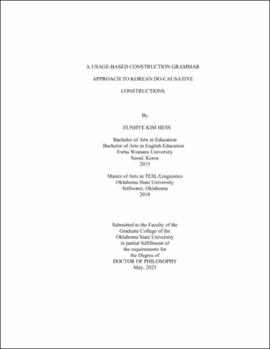| dc.description.abstract | This dissertation examined the two Korean DO-syntactic causatives, V-key HA and V-tolok HA, from a usage-based construction approach. Previous studies on the two DO-causatives have been heavily grounded in traditional or formalist grammar where the morphemes -key, -tolok, and HA were considered discrete elements, and the meaning of causation was limited to hypotheses about directedness. This dissertation takes the usage-based constructionist approach, treating V-key HA and V-tolok HA as individual constructions, pairing each form to its meaning. Also, this dissertation brings the cognitive linguistic notions of action chain and force dynamics to explore the semantics of the causative that the two constructions deliver in discourse. To answer questions about the synchronic usages of the two constructions and their relevance to the diachronic change of -key, -tolok, and their causative constructions, -key HA and -tolok HA, this dissertation explored both diachronic historical corpora and synchronic present-day corpora. The first part of the dissertation explored the semantic change of V-key and V-tolok and their development into the causative constructions, V-key HA and V-tolok HA from the 15th century to the early 20th century. The second part of the dissertation explored the synchronic usages of the two constructions in contemporary written newspaper corpora. The findings revealed that subjectification, pragmatic inferencing, metonymy, chunking, repetition, and habituation played key roles in semantic change and grammaticalization. The findings also showed the polysemous causative senses both constructions share and the distinctive central sense of each construction. The different event profiles each construction denotes trace back to the original semantics of V-key and V-tolok. This dissertation argues for the value of the usage-based constructionist approach to the study of competing constructions in Korean and the relevance of diachronic evidence in the analysis of contemporary constructions. | |
